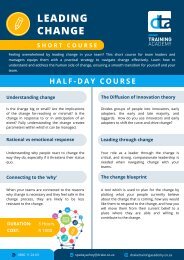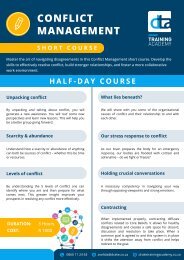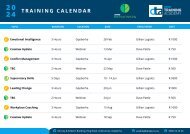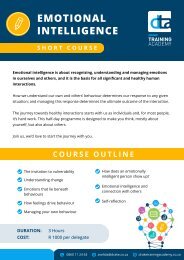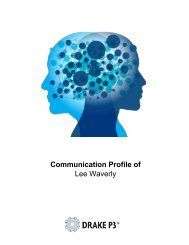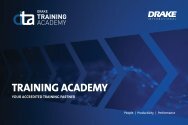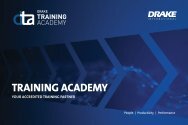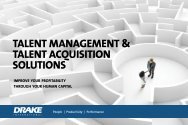The DBR Online Issue 3 - Hiring the best of the best
This electronic version of our popular quarterly Drake Business Review magazine. In each edition, you will find articles written by global thought leaders focusing on these 3 key human resource topics: People, Productivity and Performance.
This electronic version of our popular quarterly Drake Business Review magazine. In each edition, you will find articles written by global thought leaders focusing on these 3 key human resource topics: People, Productivity and Performance.
- No tags were found...
You also want an ePaper? Increase the reach of your titles
YUMPU automatically turns print PDFs into web optimized ePapers that Google loves.
ISSUE 3/2018<br />
<strong>The</strong> Drake<br />
Business<br />
Review <strong>Online</strong><br />
we found a rock star!<br />
hiring <strong>the</strong> <strong>best</strong> <strong>of</strong> <strong>the</strong> <strong>best</strong><br />
six compelling reasons why<br />
you should outsource your<br />
hr functions<br />
top five metrics for<br />
workforce analytics<br />
a drake case study<br />
tst overland express reduces<br />
turnover and improves productivity<br />
thanks to drake edmonton<br />
Photo: Edmonton, Alberta, Canada<br />
People | Productivity | Performance
people<br />
productivity<br />
performance<br />
54% 52%<br />
READ<br />
EMPLOYEES’<br />
REVIEWS<br />
LOOK UP<br />
SALARY<br />
INFORMATION<br />
According to <strong>the</strong> Undercover Recruiter blog, employers<br />
are losing a lot <strong>of</strong> opportunities by forgetting to create<br />
a mobile-friendly experience for jobseekers.<br />
• 45% <strong>of</strong> job seekers search for jobs daily on<br />
<strong>the</strong>ir mobile device<br />
• 59% say it’s important to save a job from<br />
<strong>the</strong>ir mobile device and later apply to <strong>the</strong><br />
job on a desktop<br />
• 89% <strong>of</strong> job seekers think mobile devices play<br />
a critical role in <strong>the</strong> job hunting process<br />
Going hand in hand with optimizing your website for<br />
mobile viewing is <strong>the</strong> ease in which applicants can<br />
apply to your job postings.<br />
ACCORDING TO THE HR NEWS WEBSITE<br />
ERE MEDIA, THE “APPLICATION RATES<br />
(OF MOBILE JOB SEEKERS) DROP BY<br />
A STAGGERING 365 PERCENT IF AN<br />
APPLICATION TAKES MORE THAN 15<br />
MINUTES TO COMPLETE.”<br />
Fur<strong>the</strong>rmore, <strong>the</strong> data found that simply halving<br />
<strong>the</strong> question count on an application from 50 to 25<br />
questions nearly doubles <strong>the</strong> applicant to candidate<br />
conversion rate from 5.6% to 10.6%. With today’s<br />
competitive candidate-driven talent market, top talent<br />
only stays on <strong>the</strong> market for 10 days on average. An<br />
increased applicant flow means that you can’t afford<br />
to get bogged down with your screening, interviewing<br />
and hiring processes if you want to hire <strong>the</strong> <strong>best</strong>.<br />
Contact your local Drake <strong>of</strong>fice and ask how we<br />
can assist you at any stage <strong>of</strong> <strong>the</strong> recruiting process.<br />
Choose from a full suite <strong>of</strong> Talent Acquisition<br />
Solutions to augment or outsource your current<br />
recruitment process.<br />
2 <strong>The</strong> Drake Business Review <strong>Online</strong> | <strong>Issue</strong> 3 / 2018 | drakeintl.com
people<br />
We Found a Rock Star!<br />
<strong>Hiring</strong> <strong>the</strong> Best <strong>of</strong> <strong>the</strong> Best<br />
Scenario #1: You’ve got a critical position that needs<br />
to be quickly filled by a qualified candidate. For<br />
every day <strong>the</strong> position doesn’t get filled, your inbox<br />
fills up a bit more with work to be done because<br />
your unfilled position hasn’t been staffed. You see<br />
tons <strong>of</strong> resumes and have interviewed scores <strong>of</strong><br />
candidates, but <strong>the</strong> rock star you’re looking for isn’t<br />
emerging. You refuse to “settle” for a mediocre<br />
candidate, but <strong>the</strong> work is piling up and you’ve got<br />
to do something.<br />
Scenario #2: Three months ago, you thought you<br />
had <strong>the</strong> perfect candidate for a job and decided to<br />
hire him. You negotiated a compensation package,<br />
relocated <strong>the</strong> candidate, and did some internal public<br />
relations work with <strong>the</strong> team. Two months after <strong>the</strong><br />
candidate hit <strong>the</strong> job, you realized that your candidate<br />
was a PURE (previously undetected recruiting error).<br />
<strong>The</strong> candidate had a major issue with responding to<br />
pressure and would become rude and angry with<br />
peers, employees, and customers whenever <strong>the</strong> heat<br />
was turned up.<br />
You’re now faced with ei<strong>the</strong>r making a massive<br />
investment in <strong>the</strong> person or making a job change.<br />
Not a pretty picture.<br />
Finding <strong>the</strong> right candidate for a job can be highly<br />
frustrating for both managers and recruiters. If you<br />
wait too long, <strong>the</strong> work will keep piling up and your<br />
management may start thinking you can get along<br />
without <strong>the</strong> position. Pull <strong>the</strong> trigger too soon and<br />
you risk hiring a candidate that is a PURE. <strong>The</strong>re<br />
are legitimate situations where it simply takes a<br />
long time to find a suitable candidate. You need to<br />
minimize <strong>the</strong> situations where you ei<strong>the</strong>r hire <strong>the</strong><br />
wrong candidate or take forever to find <strong>the</strong> right<br />
one. Here are some simple techniques to help you<br />
find that rock star for your organization:<br />
Know what you are looking for: Sounds basic, but<br />
it is amazing how frequently managers dust <strong>of</strong>f a<br />
job description that hasn’t been changed in years to<br />
use as <strong>the</strong> basis for hiring a new employee. <strong>Hiring</strong> to<br />
an out-dated job description can lead to ineffective<br />
resume screening and poor-fit candidates. Give <strong>the</strong><br />
job description a good working over and ensure <strong>the</strong><br />
skills documented in <strong>the</strong> job description accurately<br />
reflect what you’re looking for.<br />
3
Use multiple interviewers who can focus on different<br />
skills: Based on <strong>the</strong> job description, your candidate<br />
may need a combination <strong>of</strong> functional, technical,<br />
leadership, and people skills. A candidate who may<br />
be a technical wiz may also have <strong>the</strong> people skills <strong>of</strong><br />
a head <strong>of</strong> lettuce. Use trusted interviewers who have<br />
expertise in each area <strong>of</strong> focus and ask <strong>the</strong>m to drill<br />
<strong>the</strong> candidate for <strong>the</strong>ir respective area to ensure <strong>the</strong><br />
total skills package is <strong>the</strong>re.<br />
Look beyond <strong>the</strong> obvious: One <strong>of</strong> my <strong>best</strong> hires<br />
several years back didn’t meet <strong>the</strong> stereotypical<br />
requirements <strong>of</strong> <strong>the</strong> job but had some outstanding<br />
core skills that were easily translatable to <strong>the</strong> new<br />
job. Had I stuck with my mental image <strong>of</strong> what I<br />
was looking for, I would have rejected <strong>the</strong> candidate<br />
during <strong>the</strong> resume screening process. If your job for<br />
a procurement analyst requires strong analytical<br />
skills, consider looking at candidates from o<strong>the</strong>r<br />
functional disciplines, i.e. finance, to fill <strong>the</strong> role.<br />
I’ve continually been amazed <strong>the</strong> number <strong>of</strong> times<br />
“out-<strong>of</strong>-<strong>the</strong>-box” candidates have become rock stars.<br />
Don’t limit yourself to candidates with stereotypical<br />
requirements.<br />
Get a glimpse into critical thinking skills: You’ve<br />
probably heard about <strong>the</strong> “why manhole-covers are<br />
round” type <strong>of</strong> questions and may be chuckling at <strong>the</strong><br />
prospect <strong>of</strong> asking a candidate such an <strong>of</strong>f-<strong>the</strong>-wall<br />
question. <strong>The</strong> truth is, critical-thinking questions are<br />
a great way to understand how a candidate thinks<br />
through problems, how <strong>the</strong>y respond to pressure,<br />
and how ‘quick-on-<strong>the</strong>ir-feet’ <strong>the</strong>y can be. I’ve<br />
changed my hiring decision (both ways) based upon<br />
<strong>the</strong> critical question I asked during <strong>the</strong> interview. A<br />
great approach to this is to think about your own<br />
business and create some hypo<strong>the</strong>tical questions,<br />
i.e. if you’re an automobile manufacturer ask <strong>the</strong><br />
candidate how <strong>the</strong>y would design a car that gets 200<br />
miles per gallon. Think about <strong>the</strong> “tough questions”<br />
you can ask and observe your candidate as <strong>the</strong>y<br />
wrestle with <strong>the</strong>ir response.<br />
Get a hundred-day plan from <strong>the</strong> candidate:<br />
Wondering what a candidate would do when <strong>the</strong>y<br />
land on your doorstep? Ask <strong>the</strong>m! During your final<br />
selection process, ask each <strong>of</strong> your candidates to<br />
put toge<strong>the</strong>r a hundred-day plan <strong>of</strong> what <strong>the</strong>y are<br />
going to get accomplished during <strong>the</strong>ir first hundred<br />
days on <strong>the</strong> job. This technique is very effective<br />
in assessing how a candidate will take <strong>the</strong> ideals<br />
discussed during <strong>the</strong> interview process and put <strong>the</strong>m<br />
to action if <strong>the</strong>y were to be hired.<br />
Give peers and candidate’s prospective employees<br />
a voice: A key aspect <strong>of</strong> a candidate’s fit potential<br />
is how <strong>the</strong>y will get along with peers and, if <strong>the</strong><br />
candidate will be managing people, his or her<br />
prospective employees. You may have a functional<br />
and technical maestro but if he doesn’t have <strong>the</strong><br />
teaming or collaboration skills, you might be creating<br />
a mess for yourself and <strong>the</strong> team. Just be cautious<br />
and get a cross-section <strong>of</strong> opinions; you don’t want<br />
to base team chemistry decisions on just one person’s<br />
viewpoint.<br />
<strong>The</strong> rock stars are out <strong>the</strong>re and can be delivering<br />
value in your organization. Just make sure you keep<br />
<strong>the</strong> focus on some <strong>of</strong> <strong>the</strong>se basic hiring strategies<br />
and you’ll get <strong>the</strong> <strong>best</strong> <strong>of</strong> <strong>the</strong> <strong>best</strong> driving results<br />
for you.<br />
Personality assessments<br />
drake p3®<br />
Better hiring should be a top<br />
priority for all employers to<br />
reduce <strong>the</strong> financial impact and<br />
stress associated with turnover.<br />
<strong>The</strong> Drake P3® online assessment solution<br />
provides employers with objective, sciencebased,<br />
behavioural and personality pr<strong>of</strong>iles.<br />
It is a powerful web-based tool that provides<br />
you with a more objective and consistent<br />
means <strong>of</strong> evaluation for better hires.<br />
To find out more, contact your local<br />
Drake <strong>of</strong>fice.<br />
Reprinted with <strong>the</strong> permission <strong>of</strong> Lonnie Pacelli, an internationally recognized author <strong>of</strong> Why Don’t <strong>The</strong>y Follow Me? and Six-Word Lessons for Project Managers and<br />
o<strong>the</strong>r books. He is also president <strong>of</strong> Leading on <strong>the</strong> Edge International. His practical, no-nonsense, experience-based approach to solving tough problems has helped<br />
leaders, project managers and teams consistently deliver results. www.projectmanagementadvisor.com<br />
4 <strong>The</strong> Drake Business Review <strong>Online</strong> | <strong>Issue</strong> 3 / 2018 | drakeintl.com
a drake case study<br />
TST Overland Express<br />
reduces turnover and<br />
improves productivity<br />
thanks to<br />
Drake Edmonton<br />
Corporate pr<strong>of</strong>ile<br />
• Industry - Shipping<br />
• Countries where <strong>the</strong>y operate - Canada, US<br />
• Number <strong>of</strong> locations - 14 across Canada<br />
• Number <strong>of</strong> employees – 2000 nationwide<br />
• 45 in Edmonton<br />
About:<br />
TST Overland Express is one <strong>of</strong> Canada's leading<br />
providers <strong>of</strong> time sensitive, less than truckload (LTL)<br />
North American transportation services. Since 1928,<br />
<strong>the</strong>y have <strong>of</strong>fered unparalleled quality service and<br />
customer support, while utilizing <strong>the</strong> most current<br />
technology available to <strong>the</strong> industry.<br />
Executive Summary:<br />
TST Overland Express is one <strong>of</strong> <strong>the</strong> leading companies<br />
in Canada providing specialty and bulk trucking<br />
services across <strong>the</strong> country and into <strong>the</strong> US. <strong>The</strong>ir<br />
branch in Edmonton provides coordinated services<br />
throughout <strong>the</strong> province, with links into Nor<strong>the</strong>rn<br />
Alberta communities as well as key linkages to o<strong>the</strong>r<br />
Western Canadian locations. Due to <strong>the</strong> circumstances<br />
<strong>of</strong> <strong>the</strong>ir business and operational structure, <strong>the</strong> branch<br />
faced significant challenges in filling roles, including<br />
irregular and evening shifts.<br />
Drake’s understanding <strong>of</strong> <strong>the</strong> market, as well as our<br />
scope <strong>of</strong> recruitment experience, allowed Drake to<br />
tap into candidates who were aligned to fill evening<br />
shifts and irregular shift assignments. Due to Drake’s<br />
testing regimen, Drake was able to reduce turnover and<br />
improve <strong>the</strong> productivity on <strong>the</strong> regular shift workers<br />
as well as provide a reliable stable <strong>of</strong> part-time staff<br />
in order to fill irregular requests.<br />
<strong>The</strong> Challenge:<br />
TST’s Edmonton’s <strong>of</strong>fice was faced with multiple<br />
issues. <strong>The</strong> head <strong>of</strong>fice had instituted a hiring policy<br />
that was focused on recruiting part time personnel<br />
which limited budgets for advertising and sourcing<br />
candidates at <strong>the</strong> local level. While <strong>the</strong> positions did<br />
not require many skilled labour positions, <strong>the</strong> irregular<br />
hours and <strong>the</strong> evening shifts presented a significant<br />
challenge in recruiting reliable candidates to fill <strong>the</strong><br />
roles on a long-term basis. Turn-over and understaffing<br />
were a regular challenge faced by <strong>the</strong> branch which<br />
created a level <strong>of</strong> instability on meeting quotas and<br />
goals on a wider scale for <strong>the</strong>ir business.<br />
5
How Drake helped:<br />
When Drake first met with TST, <strong>the</strong>re were two<br />
focuses in creating a long term solution for <strong>the</strong>ir<br />
issues. <strong>The</strong> first was to develop and execute a<br />
sourcing strategy that identified candidates who<br />
were suited to evening shifts and irregular hours.<br />
By targeting those factors first, Drake was able to<br />
start building a pool <strong>of</strong> candidates who, even if <strong>the</strong>y<br />
required slightly more testing and training to start,<br />
would strongly reduce turnover and <strong>of</strong>fer higher<br />
productivity in <strong>the</strong> long term with <strong>the</strong> client. In<br />
addition to that, Drake’s recruitment policy helped<br />
continually refresh <strong>the</strong> available candidates in <strong>the</strong><br />
temporary pool for irregular hours, ensuring that<br />
short term requirements and ramp-ups could be<br />
met on a consistent basis.<br />
As Drake grew better acquainted with TST’s<br />
business needs and corporate environment, it was<br />
better able to anticipate needs and proactively add<br />
candidates for positions that were sure to be needed<br />
on a part time basis, such as admin candidates,<br />
lumpers and swampers. Over time, Drake developed<br />
a highly targeted recruitment process which not<br />
only aligned with TST’s needs, but also evolved with<br />
<strong>the</strong> company as a whole as it changed and adapted<br />
with <strong>the</strong>ir market.<br />
“WORKING WITH DRAKE IS LIKE<br />
WORKING WITH AN EXTENDED<br />
FAMILY. IT DOESN’T ALWAYS FEEL<br />
LIKE A BUSINESS TRANSACTION. IT’S<br />
A GOOD RELATIONSHIP THAT KEEPS<br />
GOING AND KEEPS GROWING. I DON’T<br />
NEED TO BABYSIT THE ACCOUNT OR<br />
WORRY THAT THEY WON’T DELIVER.<br />
DRAKE’S TEAM PROVIDES AN EASE<br />
OF RELATIONSHIP, A PLEASANT AND<br />
FRIENDLY CUSTOMER RELATIONSHIP,<br />
AND MAKE IT EFFORTLESS TO GET<br />
WHAT I NEED.” – TIFFANY MELNYK,<br />
OFFICE SUPERVISOR.<br />
Results:<br />
TST has been a Drake client<br />
for well over a decade and we<br />
continue to provide a consistent<br />
stream <strong>of</strong> high-quality, wellsuited<br />
candidates to meet TST’s<br />
needs. We have developed a<br />
strong working relationship<br />
with TST based on solid lines<br />
<strong>of</strong> communication, including<br />
regular updates and reviews. We<br />
continue to refine <strong>the</strong> process<br />
and align our sourcing to meet<br />
<strong>the</strong> developing needs <strong>of</strong> TST.<br />
Drake provides an easy process<br />
to use to source candidates, and<br />
as a reliable partner, we can<br />
meet TST’s business needs on a<br />
consistent, worry-free basis.<br />
Drake’s ability to create and deploy a<br />
targeted recruitment process capable <strong>of</strong><br />
identifying candidates who fit <strong>the</strong> unique<br />
shifts and hours TST needed was a key<br />
point in reducing churn and ensuring that<br />
shifts were fully staffed.<br />
By regularly evaluating <strong>the</strong> client’s needs<br />
and <strong>the</strong> fluctuations in <strong>the</strong> market,<br />
Drake is able to keep enough candidates<br />
in <strong>the</strong> system to ensure that needs<br />
can be swiftly met, building a trusted<br />
relationship as <strong>the</strong> partner who could<br />
deliver on-time and as needed.<br />
To find out how Drake can help you<br />
address your recruitment challenges,<br />
contact your local Drake <strong>of</strong>fice.<br />
6 <strong>The</strong> Drake Business Review <strong>Online</strong> | <strong>Issue</strong> 3 / 2018 | drakeintl.com
-24<br />
-13<br />
Dominance<br />
Extroversion<br />
+12<br />
Patience<br />
+15<br />
Conformity<br />
90% <strong>of</strong> Executives say<br />
New Hire Retention is<br />
an issue<br />
<strong>The</strong> Futurestep division <strong>of</strong> Korn Ferry conducted<br />
a survey in 2017 on <strong>the</strong> retention <strong>of</strong> new hires and<br />
received 1,817 executive responses. In addition to 90<br />
percent <strong>of</strong> executives saying that new hire retention is<br />
an issue, <strong>the</strong>y also said that between 10 percent to 25<br />
percent <strong>of</strong> new hires leave within <strong>the</strong> first 6 months.<br />
<strong>The</strong> top reason new recruits leave, according to<br />
<strong>the</strong> survey, is <strong>the</strong>ir role is different from what <strong>the</strong>y<br />
expected it would be during <strong>the</strong> hiring process. Nearly<br />
all <strong>the</strong> respondents (98 percent) said that onboarding<br />
programs are a key factor in retention efforts.<br />
Using Drake P3's® ‘Manager to<br />
Subordinate’ communication<br />
pr<strong>of</strong>ile will teach both individuals<br />
how to communicate clearly<br />
and effectively. This will remove<br />
barriers, enabling team integration<br />
to be faster while improving upon<br />
<strong>the</strong> productivity and performance<br />
<strong>of</strong> your new hire.<br />
Contact your local Drake Office and find out how<br />
Drake P3® can be used to more easily and effectively<br />
integrate your new hires.<br />
7
productivity<br />
Six Compelling Reasons<br />
Why You Should Outsource<br />
Your HR Functions<br />
<strong>The</strong> Society for Human Resources<br />
Management (SHRM) in <strong>the</strong><br />
USA conducted a survey <strong>of</strong><br />
hundreds <strong>of</strong> companies about<br />
<strong>the</strong>ir outsourcing habits.<br />
Here are <strong>the</strong> six compelling reasons<br />
companies outsource:<br />
1) 26% <strong>of</strong> companies outsource to save money.<br />
This isn’t terribly surprising. What company doesn’t<br />
want to pinch pennies where <strong>the</strong>y can?<br />
2) 23% <strong>of</strong> companies outsource to focus on strategy.<br />
Spreading yourself too thin with administrative<br />
tasks doesn’t leave a lot <strong>of</strong> time for planning, so<br />
this makes sense.<br />
3) 22% <strong>of</strong> companies outsource to improve compliance.<br />
It is increasingly challenging to stay in compliance<br />
and increasingly risky to not meet requirements so<br />
outsourcing this risk is beyond smart.<br />
8 <strong>The</strong> Drake Business Review <strong>Online</strong> | <strong>Issue</strong> 3 / 2018 | drakeintl.com
4) 18% <strong>of</strong> companies outsource to improve accuracy.<br />
If you’ve got too much on your plate (and who<br />
doesn’t?) accuracy may fall by <strong>the</strong> wayside, so this<br />
also makes sense.<br />
5) 18% <strong>of</strong> companies outsource due to a lack <strong>of</strong><br />
experience in-house. Knowing your weaknesses is<br />
as important as knowing your strengths, so handing<br />
<strong>of</strong>f a task you know you can’t handle properly to<br />
someone with expertise is a great business decision.<br />
6) 18% <strong>of</strong> companies outsource to take advantage<br />
<strong>of</strong> technological advances. With big data worth<br />
tapping into, but costly technology needed to really<br />
delve into strategic analytics, outsourcing can <strong>of</strong>fer<br />
solutions without a significant investment.<br />
SHRM followed up with ano<strong>the</strong>r question: what<br />
HR functions are companies most <strong>of</strong>ten choosing<br />
to outsource? Of those who outsource, here’s a<br />
quick rundown <strong>of</strong> <strong>the</strong> 10 tasks most commonly<br />
outsourced:<br />
• Temporary staffing<br />
• Background checks<br />
• Executive development/coaching<br />
• Pension administration<br />
• Administration<br />
• Employee assistance/counselling<br />
• Employee benefit administration<br />
• Payroll<br />
• Retirement planning<br />
• Training/management development<br />
programs<br />
unbundled recruitment<br />
Every day a position remains<br />
unfilled costs your company.<br />
You need high-quality job<br />
candidates and measurable<br />
results. You also want to<br />
ensure that your hiring<br />
process is efficient and in<br />
full regulatory compliance<br />
at every stage <strong>of</strong> <strong>the</strong> hiring<br />
process.<br />
Drake can assist you at any stage <strong>of</strong> <strong>the</strong><br />
recruiting process. Choose from a full<br />
suite <strong>of</strong> recruiting solutions to augment or<br />
outsource your current process. Solutions<br />
such as resume screening, behavioural<br />
interviewing; background checks; reference<br />
checking, skills testing, and more.<br />
Our unbundled recruitment solutions<br />
enable you to focus your time, talent and<br />
energy on growing your company.<br />
To find out more, contact your<br />
local Drake <strong>of</strong>fice.<br />
Human resources outsourcing is an excellent way<br />
for smaller companies to transform and get <strong>the</strong><br />
expertise <strong>the</strong>y need without hiring additional<br />
employees at high salaries. It also enables <strong>the</strong>m<br />
to focus on current staff and such critical issues as<br />
engagement and retention.<br />
For larger companies, compliance can be a huge risk as<br />
can legal liability, so outsourcing grants extra layers<br />
<strong>of</strong> protection. From reducing operating expenses,<br />
controlling legal risks, streamlining HR functions<br />
to focusing on <strong>the</strong> core business, outsourcing HR<br />
functions works for organizations <strong>of</strong> all shapes and<br />
sizes to help <strong>the</strong>m save time and money.<br />
9
performance<br />
Top Five Metrics for Workforce Analytics<br />
Excerpt <strong>of</strong> a White Paper by Human<br />
Capital Management Institute and<br />
Human Concepts<br />
Over <strong>the</strong> past few years, organizations have<br />
done an unprecedented amount <strong>of</strong> restructuring,<br />
retrenchment, and downsizing. Much <strong>of</strong> this has<br />
been very reactionary, without time to think or take<br />
into consideration <strong>the</strong> optimal workforce size and<br />
structure. Most companies ei<strong>the</strong>r lack metrics to<br />
measure <strong>the</strong> workforce, or measure everything and<br />
don’t know which numbers really matter.<br />
<strong>The</strong> following five key human capital metrics<br />
provide visibility to understand and analyze <strong>the</strong><br />
workforce and enable data driven decision making<br />
for <strong>the</strong> workforce. In addition, <strong>the</strong>se metrics help<br />
organizations to not inadvertently cut skills that<br />
would be critical to future success.<br />
<strong>The</strong> most advanced organizations in <strong>the</strong> world<br />
use human capital metrics and analytic tools to<br />
manage <strong>the</strong>ir workforce. With a defined human<br />
capital strategy and <strong>the</strong> following five key metrics,<br />
organizations will be better prepared to outperform<br />
competitors when opportunities surface:<br />
First Metric: Total Cost <strong>of</strong> Workforce<br />
<strong>The</strong> Total Cost <strong>of</strong> Workforce metric can be used<br />
at a macro level to measure alignment <strong>of</strong> <strong>the</strong><br />
workforce, (usually <strong>the</strong> largest single cost) with<br />
business objectives.<br />
CEO’s and top line management continually ask,<br />
“How do we know we have <strong>the</strong> right staff?” Or, “Do<br />
we have <strong>the</strong> right number <strong>of</strong> people to achieve our<br />
objectives?” <strong>The</strong>se questions will always be critical<br />
in linking workforce and business strategy. All <strong>the</strong>se<br />
questions are directed at HR; however, HR rarely<br />
has <strong>the</strong> tools to adequately answer <strong>the</strong>se questions.<br />
Total Cost <strong>of</strong> Workforce is <strong>the</strong> sum <strong>of</strong> all workforce<br />
related costs, including all compensation, benefits,<br />
and o<strong>the</strong>r employee costs. Total cost <strong>of</strong> employees<br />
includes all employee related costs for <strong>the</strong><br />
organization for a given period. <strong>The</strong> workforce is<br />
defined as employees plus contingent (contract and<br />
temporary) workers.<br />
Measuring Total Cost <strong>of</strong> Workforce allows<br />
organizations to get a true picture <strong>of</strong> <strong>the</strong>ir<br />
workforce spend and make better workforce<br />
strategy decisions. Organizations that only track<br />
employee costs are inaccurately representing <strong>the</strong>ir<br />
true workforce costs.<br />
10 <strong>The</strong> Drake Business Review <strong>Online</strong> | <strong>Issue</strong> 3 / 2018 | drakeintl.com
Embedding workforce cost information and metrics<br />
into advanced tools builds a workforce analytic<br />
capability and focus that allows users to more<br />
effectively manage <strong>the</strong> size and shape <strong>of</strong> <strong>the</strong><br />
workforce.<br />
Second Metric: Management Span <strong>of</strong> Control<br />
Management Span <strong>of</strong> Control is <strong>the</strong> <strong>best</strong> tool to<br />
address cost and structure <strong>of</strong> <strong>the</strong> management<br />
staff. When organizations are looking to optimize<br />
productivity and efficiency, this metric can be<br />
used to evaluate <strong>the</strong> overall organization as well as<br />
particular regions or business units. It is calculated<br />
by dividing <strong>the</strong> total population (including<br />
management) by <strong>the</strong> total management population.<br />
By understanding this metric and tracking it over<br />
time, organizations will gain insight into workforce<br />
trends and mix; for example, if <strong>the</strong> workforce is<br />
top heavy or if management is stretched too thin.<br />
Management Span <strong>of</strong> Control can be used to<br />
identify pockets <strong>of</strong> <strong>the</strong> workforce where a specific<br />
structure can work better than o<strong>the</strong>rs. <strong>The</strong><br />
organization can adjust and optimize by increasing<br />
span <strong>of</strong> control where workers performer better<br />
with less management intervention or decrease<br />
span <strong>of</strong> control with entry level workers who need<br />
more guidance.<br />
Using span <strong>of</strong> control, especially in large organizations,<br />
can uncover significant opportunities for cost savings,<br />
increased efficiency and productivity improvements<br />
over time.<br />
Third Metric: High Performance Turnover Rate<br />
<strong>The</strong> real key to turnover rates, in good times or bad, is<br />
how many high-performing employees are leaving<br />
<strong>the</strong> company. This can be calculated by dividing <strong>the</strong><br />
total number <strong>of</strong> high-performing employees that<br />
terminated in a given period by <strong>the</strong> average high<br />
performer population at <strong>the</strong> organization over<br />
<strong>the</strong> same period. Without accurate calculations to<br />
identify <strong>the</strong> true cost <strong>of</strong> turnover, and how it varies<br />
between performance levels across segments <strong>of</strong><br />
<strong>the</strong> workforce, organizations don’t have <strong>the</strong> right<br />
information for data driven decision making and<br />
launching intervention strategies.<br />
<strong>The</strong> key questions to ask yourself are: “What is<br />
our high-performer turnover rate?” and, “What<br />
percentage <strong>of</strong> our <strong>best</strong> people are we losing?”<br />
<strong>The</strong> key is to track a metric that not only tells you<br />
about your organization, but that is also predictive.<br />
Turnover alone only tells you how many employees<br />
you’ve lost. High Turnover Rate indicates <strong>the</strong> value<br />
<strong>of</strong> that loss; it’s predictive <strong>of</strong> pure talent loss. If your<br />
overall turnover rate is only 4%, but your highperformer<br />
turnover rate is 8%, you’re bleeding talent.<br />
Fourth Metric: Career Path Ratio<br />
Career Path Ratio shows <strong>the</strong> rate <strong>of</strong> upward<br />
movement versus lateral movement in an<br />
organization. If you think <strong>of</strong> organizations as a<br />
pyramid, <strong>the</strong>re is a limited amount <strong>of</strong> up, but <strong>the</strong>re’s<br />
an almost unlimited amount <strong>of</strong> over. <strong>The</strong>re is a<br />
great deal <strong>of</strong> transfer capability for many different<br />
pr<strong>of</strong>essional and executive roles. This is a very lowcost<br />
way to enhance and build workforce capability<br />
over time and stretch and challenge workers with<br />
a minimal increase to workforce costs.<br />
Career Path Ratio is calculated by dividing total<br />
promotions by total movement at <strong>the</strong> organization.<br />
This metric combines two important measures that<br />
reflect mobility toge<strong>the</strong>r into one metric that is more<br />
meaningful: total promotions and total transfers.<br />
If <strong>the</strong> ratio is close to 1, <strong>the</strong>n it means <strong>the</strong><br />
organization is ei<strong>the</strong>r doing too many promotions,<br />
or it’s not doing enough transfers. Career Path Ratio<br />
can be calculated at an aggregate level for <strong>the</strong><br />
entire company, business unit, or by position group.<br />
Analyzing Career Path Ratio in combination with<br />
employee retention and performance enables<br />
companies to identify linkages between mobility<br />
and drivers <strong>of</strong> critical workforce issues. Identifying<br />
true drivers <strong>of</strong> engagement, performance, and<br />
retention allow organizations to use mobility to<br />
shape results and improve workforce productivity<br />
and business performance, while effectively<br />
managing workforce costs.<br />
11
Fifth Metric: Talent Management Index<br />
Talent Management Index is a combination <strong>of</strong><br />
metrics that work toge<strong>the</strong>r holistically across <strong>the</strong><br />
entire employee lifecycle. It allows organizations to<br />
evaluate and analyze talent management practices<br />
for recruiting, mobility, performance management,<br />
training and development, and turnover and<br />
retention. Tracking Talent Management Index<br />
also enables organizations to hold all levels <strong>of</strong><br />
management accountable for management<br />
practices and quality by measuring effectiveness<br />
<strong>of</strong> hiring practices, success <strong>of</strong> training and<br />
development efforts, and cost efficiency.<br />
While many metrics could potentially be included in<br />
an organization’s Talent Management Index, below<br />
are five recommended metrics, several <strong>of</strong> which are<br />
also included in our top five metrics for workforce<br />
analytics:<br />
1. New Hire High Performer Rate. It’s calculated by<br />
<strong>the</strong> percentage <strong>of</strong> new hires, rated by individual<br />
organization standards, as high-quality, high<br />
potential or high-performing employees.<br />
2. Percent <strong>of</strong> High Performers. It measures <strong>the</strong><br />
percent <strong>of</strong> <strong>the</strong> population that is rated as high<br />
performing. <strong>The</strong> <strong>best</strong> use <strong>of</strong> this metric, when<br />
calculated as part <strong>of</strong> Talent Management Index, is<br />
on an individual manager basis to hold management<br />
accountable for nurturing and developing <strong>the</strong><br />
organization’s most promising talent.<br />
3. Career Path Ratio. It measures relative upward<br />
and lateral mobility at <strong>the</strong> organizations. For<br />
optimal use, it should be calculated by individual<br />
manager.<br />
This metric should also be calculated on an individual<br />
manager basis. For effective talent management<br />
at any organization, <strong>the</strong> focus should always be on<br />
identifying, grooming, managing and retaining top<br />
talent. <strong>The</strong> power <strong>of</strong> <strong>the</strong> Talent Management Index<br />
lies in evaluating individual managers and making<br />
targeted improvements for overall organizational<br />
performance and productivity through effective<br />
talent management practices.<br />
Summary:<br />
<strong>The</strong> potential <strong>of</strong> <strong>the</strong>se top five metrics is significant,<br />
and <strong>the</strong> greatest value can be achieved when <strong>the</strong>y<br />
are linked to financial metrics, such as revenue<br />
or pr<strong>of</strong>it for FTE, for example. By leveraging key<br />
metrics to predict future outcomes, organizations<br />
have <strong>the</strong> ability to identify potential issues before<br />
<strong>the</strong>y become too problematic, calculate <strong>the</strong> financial<br />
impact, and formulate a strategy for intervention.<br />
Reprinted with <strong>the</strong> permission <strong>of</strong> Human Capital Management Institute (HCMI)<br />
and Human Concepts. Co-authored by Jeff Higgins, Grant Cooperstein and Moun<br />
Peterson <strong>of</strong> HCMI, and Katy Colletto <strong>of</strong> Human Concepts. For more information,<br />
visit www.hcminst.com and www.humanconcepts.com.<br />
drake analytics<br />
Drake Analytics helps<br />
organizations accelerate<br />
<strong>the</strong>ir understanding <strong>of</strong><br />
HR data and use this<br />
knowledge strategically<br />
to drive business impact.<br />
Read <strong>the</strong> complete White Paper<br />
4. Total Cost <strong>of</strong> Workforce. It may be hard to see how<br />
cost <strong>of</strong> workforce relates to talent management;<br />
however, <strong>the</strong> <strong>best</strong> managers are able to achieve<br />
better results while reducing overall workforce<br />
costs. <strong>The</strong>y build, ra<strong>the</strong>r than buy, <strong>the</strong> <strong>best</strong> talent.<br />
5. High Performer Turnover Rate. This metric<br />
allows organizations to measure management<br />
effectiveness in retaining top talent at <strong>the</strong><br />
organization.<br />
12 <strong>The</strong> Drake Business Review <strong>Online</strong> | <strong>Issue</strong> 3 / 2018 | drakeintl.com
Since 1951, Drake International has been helping companies around <strong>the</strong> world increase <strong>the</strong>ir productivity<br />
and performance by hiring <strong>the</strong> right people and using <strong>the</strong> right Talent Management Solutions.<br />
Visit our website to learn how we can help you with your People, Productivity, and Performance issues.<br />
Website (Canada)<br />
Website (South Africa)<br />
Website (New Zealand)<br />
Website (Australia)<br />
Website (United States)<br />
Website (Singapore)<br />
Website (United Kingdom)<br />
Website (Hong Kong)<br />
Website (Philippines)<br />
People | Productivity | Performance<br />
13




